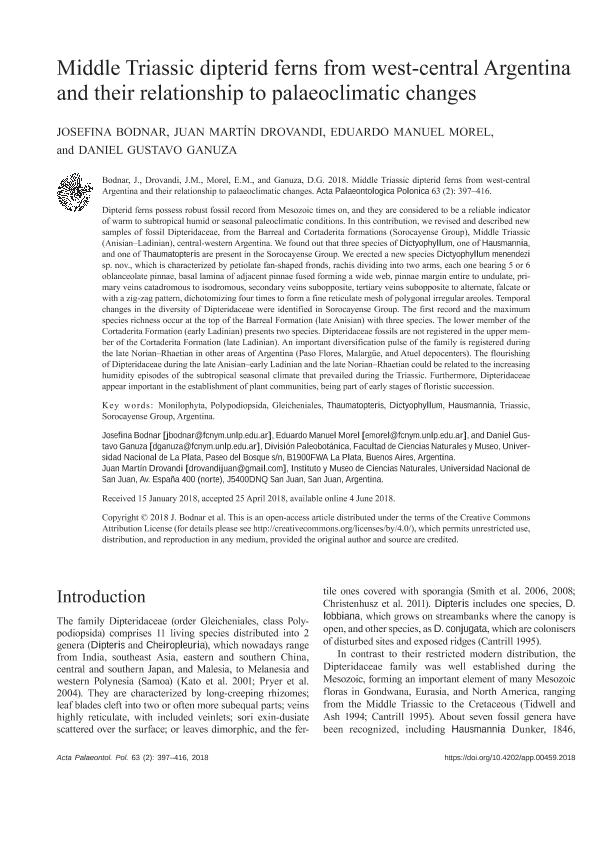Artículo
Middle Triassic dipterid ferns from west-central Argentina and their relationship to palaeoclimatic changes
Fecha de publicación:
06/2018
Editorial:
Polish Academy of Sciences. Institute of Paleobiology
Revista:
Acta Palaeontologica Polonica
ISSN:
0567-7920
e-ISSN:
1732-2421
Idioma:
Inglés
Tipo de recurso:
Artículo publicado
Clasificación temática:
Resumen
Dipterid ferns possess robust fossil record from Mesozoic times on, and they are considered to be a reliable indicator of warm to subtropical humid or seasonal paleoclimatic conditions. In this contribution, we revised and described new samples of fossil Dipteridaceae, from the Barreal and Cortaderita formations (Sorocayense Group), Middle Triassic (Anisian–Ladinian), central-western Argentina. We found out that three species of Dictyophyllum, one of Hausmannia, and one of Thaumatopteris are present in the Sorocayense Group. We erected a new species Dictyophyllum menendezi sp. nov., which is characterized by petiolate fan-shaped fronds, rachis dividing into two arms, each one bearing 5 or 6 oblanceolate pinnae, basal lamina of adjacent pinnae fused forming a wide web, pinnae margin entire to undulate, primary veins catadromous to isodromous, secondary veins subopposite, tertiary veins subopposite to alternate, falcate or with a zig-zag pattern, dichotomizing four times to form a fine reticulate mesh of polygonal irregular areoles. Temporal changes in the diversity of Dipteridaceae were identified in Sorocayense Group. The first record and the maximum species richness occur at the top of the Barreal Formation (late Anisian) with three species. The lower member of the Cortaderita Formation (early Ladinian) presents two species. Dipteridaceae fossils are not registered in the upper member of the Cortaderita Formation (late Ladinian). An important diversification pulse of the family is registered during the late Norian–Rhaetian in other areas of Argentina (Paso Flores, Malargüe, and Atuel depocenters). The flourishing of Dipteridaceae during the late Anisian–early Ladinian and the late Norian–Rhaetian could be related to the increasing humidity episodes of the subtropical seasonal climate that prevailed during the Triassic. Furthermore, Dipteridaceae appear important in the establishment of plant communities, being part of early stages of floristic succession.
Palabras clave:
Monilophyta
,
Polypodiopsida
,
Gleicheniales
,
Thaumatopteris
Archivos asociados
Licencia
Identificadores
Colecciones
Articulos(CCT - LA PLATA)
Articulos de CTRO.CIENTIFICO TECNOL.CONICET - LA PLATA
Articulos de CTRO.CIENTIFICO TECNOL.CONICET - LA PLATA
Citación
Bodnar, Josefina; Drovandi, Juan Martín; Morel, Eduardo Manuel; Ganuza, Daniel Gustavo; Middle Triassic dipterid ferns from west-central Argentina and their relationship to palaeoclimatic changes; Polish Academy of Sciences. Institute of Paleobiology; Acta Palaeontologica Polonica; 63; 2; 6-2018; 397-417
Compartir
Altmétricas




